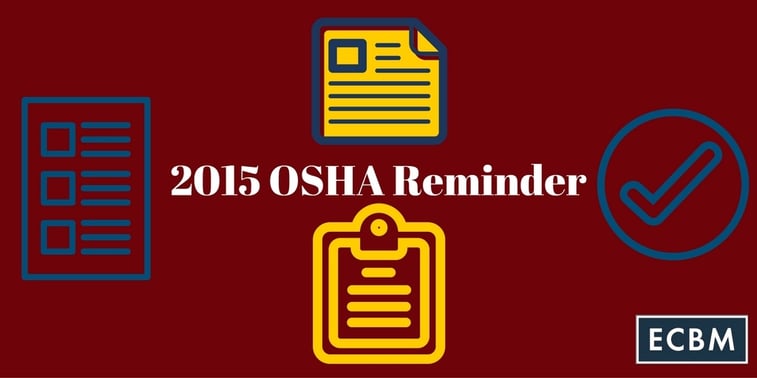REMINDER: Post Your 2014 OSHA Recordkeeping Annual Summary By February 1, 2015

OSHA continues its focus of inspecting and, when alleged violations found, citing employers under its recordkeeping standard. Proper recordkeeping has become more critical to employers since OSHA is considering a proposed rule to publish, in certain cases, the injury and illness data provided by employers.
All employers required to maintain the Occupational Safety and Health Administration’s 300 Logs for workplace injuries and illnesses must post their 2014 annual summary by February 1, 2014, using the annual summary form (form 300A). The summary must list the total number of job-related injuries and illnesses that occurred in calendar year 2014 and logged on the OSHA 300 Form. This form is available for downloading from the OSHA website at www.osha.gov. If you have been using ECBM’s MyWaveOSHA portal to log your recordable incidents throughout the year, creating and printing the log (form 300) and the summary report (form 300A) is a snap. Open your MyWave portal to MyWaveOSHA site to access your full OSHA reporting and analysis capabilities.
Review Your Records
Before the annual summary is prepared, the recordkeeping rule imposes an express duty on the employer to review the Log (form 300) to verify that entries are complete and accurate. Make sure that you take time to review the forms for technical errors as well as to review accident reports and other materials, and ensure that all recordable incidents have been included. An employer has a duty to update and maintain records for five years plus the current year and provide them for inspection to OSHA investigators when requested.
Total Hours Worked and Average Number of Employees
The annual summary requires employers to include a calculation of the annual average number of employees covered by the Log and the total hours worked by all covered employees (full time, part-time, temporary and/or seasonal). The purpose of this requirement is to help employers compare the relative frequency of significant occupational injuries and illnesses at their workplace as compared to other establishments as reported by the Bureau of Labor Statistics.
Certification of Summary Report
Once the summary report is completed, OSHA requires the certification of the 300A by a company executive. There are four specific management officials who OSHA considers to be a “company executive” for purposes of certifying the report. These are: 1) an owner of the company; 2) an officer of the corporation; 3) the highest-ranking company official working at the establishment; or 4) the immediate supervisor of the highest-ranking company official working at the establishment. This official must certify that he or she has reviewed the related records and reasonably believes in the integrity and accuracy of the reported data. Note that normally, HR Managers or Safety Directors cannot sign the OSHA 300A summary unless they are an officer of the company.
Posting Period
The posting period is for three months, from February 1st to April 30th and posted at each establishment/location in a common area wherever notices to employees are usually posted. Even if there were no recordable injuries or illnesses, you must still complete and post the 300A summary with zeros.
New Reporting and Recordkeeping Rules for 2015
As of January 1, 2015, OSHA Standard, 29 CFR Subpart 1904.39, Reporting Fatality, Injury and Illness Information to the Government requires covered employers to report work-related fatalities to OSHA within eight hours of learning of the event, and report all work-related in-patient hospitalizations, amputations and losses of an eye to OSHA within 24 hours of learning of the event.
Additionally, beginning in 2015, OSHA made changes to the list of partially exempt industries that are not required to keep OSHA logs. Some previously exempt industries are now required to keep OSHA logs. For additional information regarding these new OSHA standards, visit OSHA’s recordkeeping page at: https://www.osha.gov/recordkeeping/index.html
We’re Here to Help!
If you have any questions regarding OSHA’s emphasis on its recordkeeping standard requirements, want a quick review of your OSHA 300 logs and 300A summaries, wish to utilize ECBM’s MyWave portals for OSHA recordkeeping and analysis, or for training of your recordkeepers, please contact your Broker or Barbara Taylor at ECBM at 888-313-3226.
Click Here for printable version of this reminder
